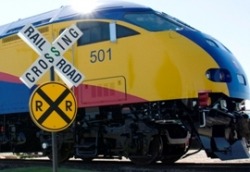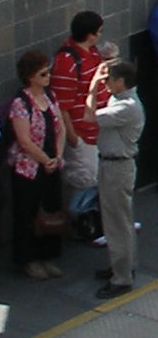SAFETY AND YOU

Northstar Commuter Rail will be very safe, but living and working around commuter rail trains and tracks requires all community members to pay attention, obey warning signs and comply with safety barriers.
Remember that freight trains and Northstar Commuter Rail trains will share BNSF Railway tracks, so train traffic will be more frequent and unpredictable than the times listed on Northstar’s schedule. Follow the links below to find out how to stay alert and stay safe on the Northstar Line.
Remember that freight trains and Northstar Commuter Rail trains will share BNSF Railway tracks, so train traffic will be more frequent and unpredictable than the times listed on Northstar’s schedule. Follow the links below to find out how to stay alert and stay safe on the Northstar Line.
SAFETY NEAR COMMUTER RAIL STATIONS

- Trains can come on any track, at any time, from either direction. Never assume you know when and where to expect a train.
- Cross rail tracks only at clearly marked and designated crossings, and look both ways for trains before crossing.
- Slow down and be alert near commuter rail stations. Watch for trains, pedestrians, bicyclists, buses and cars.
- While waiting for the train, always stand behind the yellow line on the station platform.
- Never lean over the yellow line. You may lose your balance or slip and fall onto the rail tracks.
- Listen for bells and horns. They alert you to an oncoming train – even if you can’t see it.
- Cross rail tracks only at clearly marked crossings.
- Running on the station platform is prohibited.
- Do not approach the train until it has come to a complete stop. Keep children together and away from the rail tracks until the train stops completely.
- Before you board, always allow other passengers to exit the train.
- Avoid sticking arms or legs in the doors to prevent them from closing.
- Skateboarding, rollerblading and riding bicycles on station platforms is not permitted.
- In an emergency, dial 911.
- Always obey warning signs and sounds.
- Listen for train whistles notifying you that a train is approaching.
- White headlights indicate a train is coming toward you; red or no taillights mean a train is moving away from you.
- Be aware that Northstar Commuter Rail trains can operate in both directions, sometimes with a passenger car on the front end. Do not assume the train is moving away from you if you don’t see a locomotive engine.
- Look both ways before crossing rail tracks at designated crossings — Northstar and freight trains can travel in either direction.
- Environmental noise and wide-open spaces can muffle warning whistles or the sounds of trains, so always stay alert around rail tracks and Northstar stations.
- Special areas are designated for elderly customers and those with disabilities. Please surrender these seats when they are needed by passengers.
- There will be a small gap between the train and the platform so watch your step when boarding and exiting the train. The gap exists for train safety, so it does not touch the platform while it is moving.
- While riding the train, please remain seated. If standing, hold onto the handrails in case of sudden stops.
- Keep children under control while riding. Running on the train can be dangerous.
- Keep your belongings free of the aisles and out of others’ way – each Northstar passenger car will have storage areas for large bags.
- Do not leave valuables unattended.
- Tracks have powerful switches that can move at any time. Never walk on tracks and stay away from track switches.
- Cross tracks only at clearly marked and designated crossings.
- Never try to beat a train through a crossing. Commuter and freight rail trains can take a half mile or more to come to a complete stop once emergency braking is applied.
- Never go around lowered gates at rail track crossings. Trains have the right of way over all other forms of transportation.
- Safety only takes a minute. If gate arms are going down, stop. The train will clear the intersection soon.
- The weight ratio of a train to an automobile is similar to the weight ratio of an automobile to a soda can. Locomotives alone weigh more than 200 tons.
- Expect trains at any time on Northstar tracks. Northstar trains will share train tracks with frequent and unscheduled freight trains.
- Trains may travel directly behind each other, or pass on adjacent tracks that may not be visible to you. Stay alert for passing trains at all times.
- Always look both ways, listen for warning signals and obey warning signs before proceeding through designated track crossings. Cross tracks only at designated crossings.
- Never place or throw anything on the rail tracks. Foreign objects may cause trains to derail, endangering passengers and bystanders. Objects on the tracks may also shoot out from under train wheels endangering bystanders.
- Drive slowly and watch for pedestrians, bicyclists, buses and cars.
- Passengers should only be dropped off in clearly marked drop-off zones near the stations.
- Be aware of your surroundings and stay in the well-lit platform and park and ride areas. If you feel unsafe, call 911.
- Do not leave valuables in your vehicle, and keep your parked vehicle locked. Neither the Northstar Commuter Rail Project nor Metro Transit will be responsible for lost or stolen items. Visit the Metro Transit lost and found pagefor more information.
- Northstar station parking lots prohibit overnight parking.
- In an emergency at the station or park and ride lots, call 911.
- If you observe or experience an emergency situation on the train, the emergency call box in Northstar passenger cars will allow you to contact the engineer.
- If an emergency occurs while riding Northstar trains, stay calm, stay seated and observe instructions from the train conductor or engineer.
- Use covered shelters and on-demand heating systems located on Northstar platforms.
- Detour information during inclement weather is provided seasonally in a detour brochure. It is made available online and on transit fleet.
- Use caution on platforms and around train tracks. Sidewalks, platforms and parking lots may be slippery in wet weather.
- Stay alert. Trains can be more difficult to hear and see during storms.
- Leave extra time for travel to and from the train station in bad weather conditions.
- Train passenger car floors may be slippery when wet. Use caution and handrails when boarding and exiting train cars.
